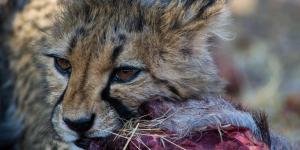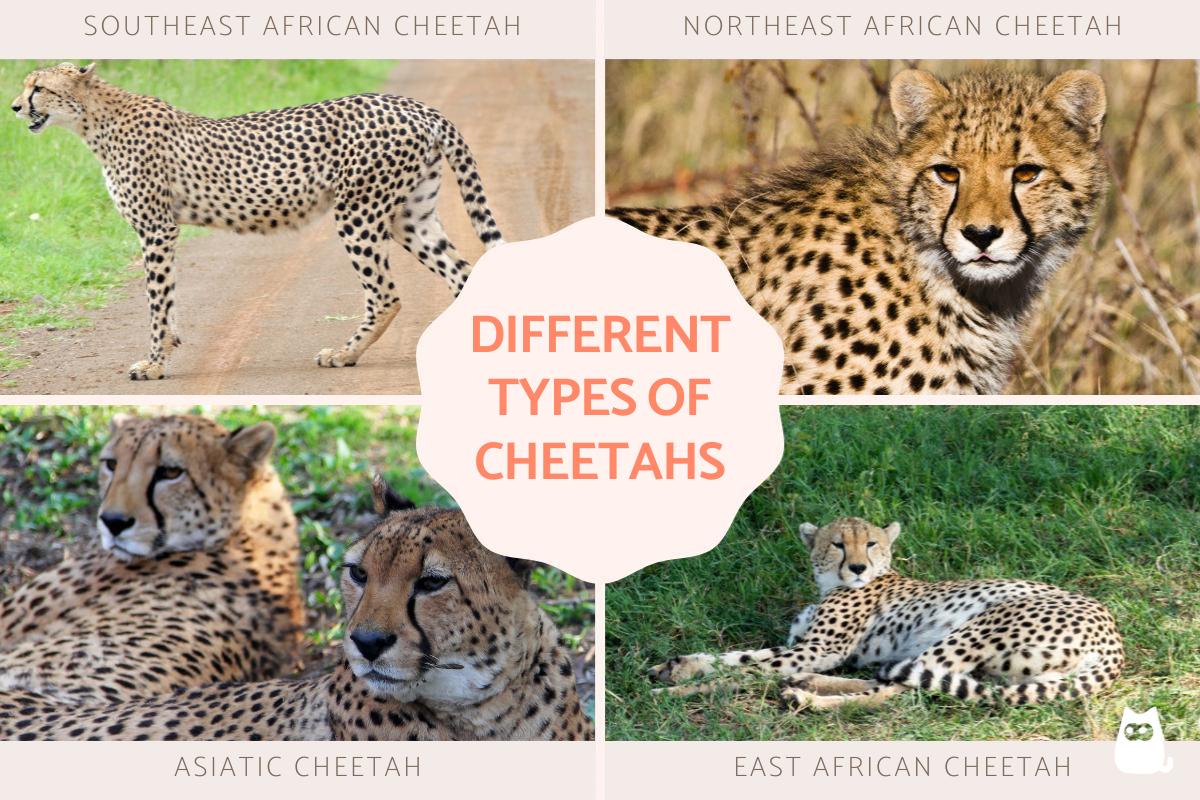Different Types of Cheetahs


You will be forgiven for thinking there is only one kind of cheetah (Acinonyx jubatus). This iconic feline is a big cat species known for its incredible speed and adaptability to various habitats. While it is true there is only one species of this animal, there are different cheetah types known as subspecies. While sharing the same characteristics that bind them to their taxonomic classification, they have sufficient differences to warrant the designation of subspecies. One of the most important influences in these influences is habitat, with each subspecies representing populations in different areas. All are remarkable predators with great speed and unique adaptations to their environment. Unfortunately, this does not stop many threats to their future conservation.
AnimalWised looks at the different types of cheetahs by sharing the four extant cheetah subspecies. We share some facts about each kind of cheetah, as well as look at what threats they face in their respective habitats.
Southeast African cheetah (Acinonyx jubatus jubatus)
The Southeast African cheetah is the most populous and widely distributed cheetah subspecies type. It lives mainly in southern African countries such as South Africa, Namibia, Botswana and Zimbabwe. Within these population ranges, it finds refuge in vast savannas and arid areas.
Their fur is golden yellow, with characteristic black spots and teardrop-shaped lines running from the eyes to the snout. This is a distinctive feature that is believed to help reduce the glare of the sun while hunting. The spots of the Southeast African cheetah are generally considered to be denser than those of other cheetah subspecies.
Thanks to their increased numbers and conservation programs in nature reserves, this subspecies has a relatively stable population. Despite this, it remains vulnerable to habitat loss and conflicts with farmers seeking to protect their livestock.
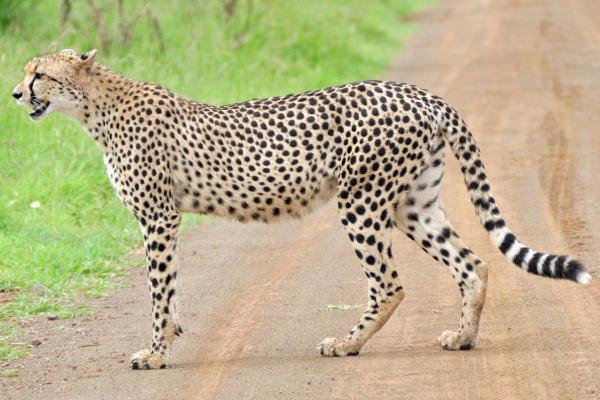
Northwest African cheetah (Acinonyx jubatus hecki)
While the Southeast African cheetah may have a stable population, the same cannot be said for this cheetah subspecies. Also known as the Saharan cheetah, the Northwest African cheetah is on the brink of extinction.
This subspecies is found in the most inhospitable areas of the Sahara, in countries such as Algeria, Mali and Niger. Adapted to the harsh conditions of the desert, this cheetah is smaller than other subspecies. Its fur is also paler, with less marked spots. Such a coat allows it to camouflage better in the sandy environment they call home.
The Saharan cheetah habitat consists of desert and semi-arid areas. It is increasingly threatened by climate change and human expansion. With fewer than 250 individuals left in the wild, this subspecies faces an uncertain future. Its conservation and preservation depends on urgent measures to protect its range.
You can discover more about cheetah habitat by checking out our related guide explaining where do cheetahs live?

Northeast African cheetah (Acinonyx jubatus soemmeringii)
This subspecies inhabits the Horn of Africa, including Sudan, Eritrea and Ethiopia. For this reason, it is also known as the Sudan cheetah. This type of cheetah is characterized by its medium size. Its coat has larger and more widely spaced spots than other cheetah subspecies. Its tail is often more marked with black bands, also distinguishing it from other types.
The Northwest African cheetah is found in dry savannahs and open woodlands, where it has sufficient cover to stalk its prey. However, like other subspecies, it faces pressure from poaching, degradation of its environment and increasing human activity that limits its territories.

Asiatic cheetah (Acinonyx jubatus venaticus)
The Asiatic cheetah is the most endangered type of all cheetahs and one of the most worrying cases in terms of conservation. This subspecies once had a wide population distribution ranging from the Middle East to India, but now survives only in Iran, with a wild population of less than 30 individuals.
Its fur is paler and its body slimmer compared to African cheetah subspecies, an adaptation to the mountainous and desert regions where it lives. This cheetah faces unique challenges, such as a lack of natural prey, extreme fragmentation of its habitat and the need to coexist with human communities in rural areas. The intensive work of Iranian conservationists is the only thing keeping this subspecies from the brink of total extinction.
If you want to learn a little more about the diet of this big cat, check out our article sharking the different types of animals cheetahs eat.
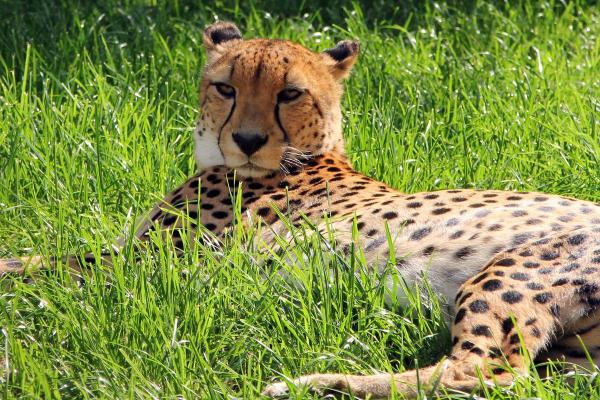
East African cheetah (Acinonyx jubatus jubatus)
We have already stated there are four extant subspecies of the cheetah. The East African cheetah refers to a population of Southeast African cheetahs which have been given thei own loose designation. While they were once proposed to be a distinct subspecies known as Acinonyx jubatus raineyi, genetic studies showed they were top similar to the Southeast African cheetah to warrant the designation.
Despite this, there are differences in the East African cheetah which make them distinct. One of the largest kinds of cheetah, they occupy open grasslands and savannas. Their densely packed spots provide effective camouflage in its surroundings.
This type of cheetah shares its habitat with large predators such as lions and hyenas, forcing it to hunt mainly during the day to avoid confrontations. Despite being more abundant than the Asiatic or Northwest African cheetah, its population is also declining due to habitat loss and competition with human activities.
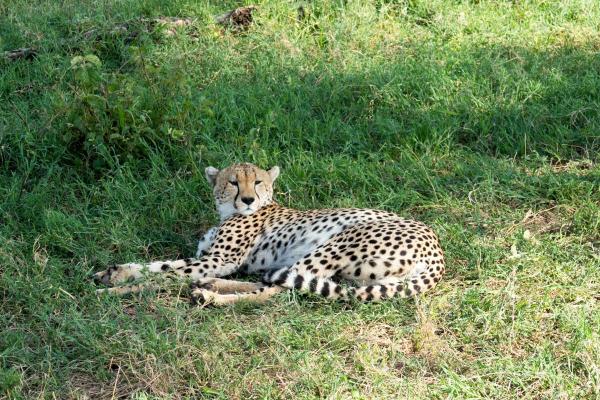
King cheetah
The king cheetah is another type of cheetah, but it does not correspond to a distinct subspecies. It was once proposed as a separate species altogether to be known as the king cheetah (Acinonyx rex), but this has since been rejected. Instead of a separate species, king cheetahs are cheetahs of various subspecies which have a genetic variation manifesting in a distinct coat pattern.
King cheetah coats have larger spots and very broad black lines to give a unique, as you can see in the photo below. Local legend even claimed the animal was a cross between a cheetah and a hyena due to the similarity of their coat to the latter. This mutation is rare and is found primarily in southern Africa, highlighting the genetic diversity within this species.
If you sometimes confuse cheetahs with other big cats, our article explaining the difference between a cheetah, leopard and jaguar might elucidate things for you.
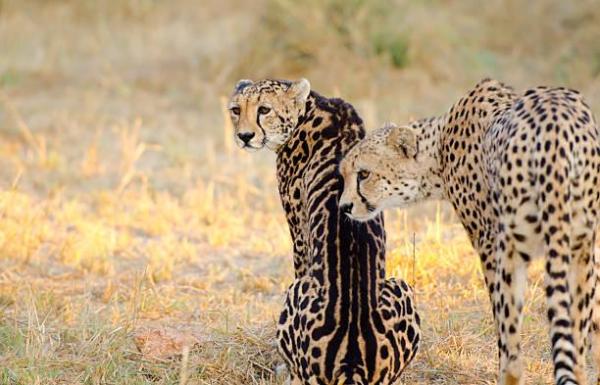

If you want to read similar articles to Different Types of Cheetahs, we recommend you visit our Facts about the animal kingdom category.
- Freeman, A. R., MacHugh, D. E., McKeown, S., Walzer, C., McConnell, D. J., & Bradley, D. G. (2001). Sequence variation in the mitochondrial DNA control region of wild African cheetahs (Acinonyx jubatus). Heredity, 86(3), 355–362.
https://doi.org/10.1046/j.1365-2540.2001.00842.x - Krausman, P. R., & Morales, S. M. (2005). Acinonyx jubatus. Mammalian Species, 771, 1–6.
- Prost, S., Machado, A. P., Zumbroich, J., Preier, L., Mahtani‐Williams, S., Meissner, R., … Burger, P. A. (2022). Genomic analyses show extremely perilous conservation status of African and Asian cheetahs (Acinonyx jubatus). Molecular Ecology, 31(16), 4208–4223.
https://doi.org/10.1111/mec.16524 - Weise, F. J., Vijay, V., Jacobson, A. P., Schoonover, R. F., Groom, R. J., Horgan, J., … Pimm, S. L. (2017). The distribution and numbers of cheetah (Acinonyx jubatus) in southern Africa. PeerJ, 5, e4096.
https://doi.org/10.7717/peerj.4096



